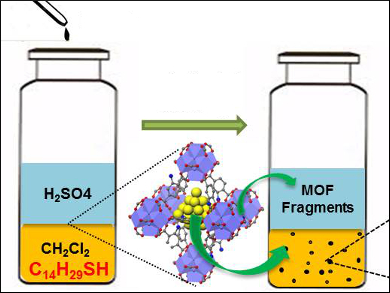Metal nanoclusters (NCs) are a well-known class of nanomaterials. Their highly compact sizes result in increased surface-to-volume ratios and catalytically relevant under-coordinated surface sites. The synthesis of monodisperse ultra-small (< 2 nm) NCs also enables a systematic investigation of size-dependent chemical and physical properties. Gold NCs have been extensively studied. Palladium NCs have received much less attention because of the challenging preparation of monodisperse Pd NCs.
Wenyu Huang, Iowa State University, Ames, USA, and colleagues developed an easy interfacial etching strategy for the synthesis of monodisperse and ultra-small thiolated Pd NCs. The group used amine-functionalized zirconium metal-organic frameworks (MOFs) as sacrificial templates to synthesize the Pd NCs. The Pd NCs were first prepared inside the MOF’s cavities by adding palladium acetate solution to a solution of the metal-organic framework. The MOF was then removed with H2SO4. To prevent agglomeration of the NCs, the thiol ligand n-tetradecanethiol was added.
The NCs released from the MOFs have a very small size with narrow distribution (1.1 ± 0.1 nm). Moreover, the diameter of the clusters can be tuned using MOFs with different cavity sizes. The thiolated Pd NCs are catalytically active in a model Suzuki-Miyaura coupling reaction. This method opens up a new way to synthesize ultrasmall and monodisperse metal NCs.
- Synthesis of Monodisperse Palladium Nanoclusters Using Metal-Organic Frameworks as Sacrificial Templates,
Xinle Li, Chaoxian Xiao, Tian Wei Goh, Alexandria L. D. Stanton, Yuchen Pei, Prashant K. Jain, Wenyu Huang,
ChemNanoMat 2016.
DOI: 10.1002/cnma.201600121



![Synthesis of [c2]Daisy Chains via Mechanochemistry](https://www.chemistryviews.org/wp-content/uploads/2025/04/202504_RotaxanesWithSolidStateMechanochemistry-125x94.png)
